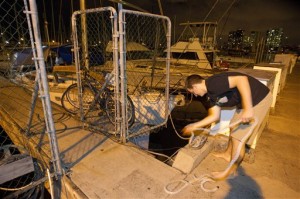ANCHORAGE, Alaska — Emergency sirens sounded around Hawaii late Saturday warning about an oncoming tsunami, after a powerful earthquake struck off the coast of Canada.
Even as emergency officials urged people along Hawaii’s coasts to move to higher ground, officials in North America downgraded a tsunami warning to an advisory for southern Alaska and British Columbia. They also issued an advisory for areas of northern California and southern Oregon.
A small tsunami created by the magnitude 7.7 quake was barely noticeable in Craig, Alaska, where the first wave or surge was recorded Saturday night.
The wave or surge was recorded at 4 inches (101.6 millimeters), much smaller than forecast, said Jeremy Zidek, a spokesman for the Alaska Department of Homeland Security and Emergency Management.
The U.S. Geological Survey said the 7.7-magnitude earthquake hit in the Queen Charlotte Islands area, followed by a 5.8-magnitude aftershock several minutes later. The quake was felt in Craig and other southeast Alaska communities, but Zidek said there were no immediate reports of damage.
The West Coast and Alaska Tsunami Warning Center issued a warning for coastal areas of southeast Alaska, down the western Canadian coast to the tip of Vancouver Island.
Later Saturday evening, the warning for those areas was downgraded to an advisory, while a warning was issued for Hawaii.
Officials said a tsunami wave could hit the islands by 10:30 p.m. Saturday (1:30 a.m. PDT).
Local television stations in Hawaii were running live news updates and warning tourists to check with hotels.
At first, officials said the islands weren’t in any danger of a tsunami, but they later issued a warning, saying there had been a change in sea readings.
A tsunami warning means an area is likely to be hit by a wave, while an advisory means there may be strong currents, but that widespread inundation is not expected to occur.
Lucy Jones, a USGS seismologist, said the earthquake likely would not generate a large tsunami.
“This isn’t that big of an earthquake on tsunami scales,” she said. “The really big tsunamis are usually up in the high 8s and 9s.”
She said the earthquake occurred along a “fairly long” fault – “a plate 200 kilometers long” in a subduction zone, where one plate slips underneath another. Such quakes lift the sea floor and tend to cause tsunamis, she said.
